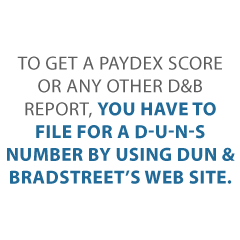- Connect With Us!
- (877) 600-2487
- info@creditsuite.com
10 Factors You Need to Know Affecting Your D & B Report
Published By Janet Gershen-Siegel at February 26th, 2018
What is Your D & B Report All About?
Your D & B Report (also known as your (Dun & Bradstreet Report) is one of the first things a business will look at when deciding whether to do so business with you at all. Dun & Bradstreet is a business services giant. And they offer database-generated reports to their clients. These are to help their clients decide if you are a good credit risk. So this is the case whether you are a potential vendor, supplier, or business partner.
Getting Reports
To get a PAYDEX score or any other D&B report, you have to file for a D-U-N-S number by using Dun & Bradstreet’s web site. The number is cost free. Plus the CRA will need to have records of your payments with four or more sellers.
Why Do These Reports Matter?
A company will rely on the D & B Report about your firm in order to make informed business credit decisions and avoid bad debt. Dun & Bradstreet takes several factors into account in creating such a report. So let’s look at all of these factors in turn.
1. D & B Report Delinquency Predictor
To figure out how likely your company is to be late in paying your debts, Dun & Bradstreet uses predictive models. They use predictive scoring. So that takes historical information to try to predict future outcomes. D & B identifies the risks inherent in a future decision, by comparing historical information to a future event.
The idea is to take objective and statistically derived data. So this is rather than subjective and intuitive judgments. They use a scoring system to rank and order accounts based on the probability of late payments. However, Predictive Scoring only represents a statistical probability. So it is not a guarantee.
2. Financial Stress Percentile
The Financial Stress Percentile compares your company to other businesses. So these are in the same region, industry, number of employees, or number of years in the business. Financial Stress Score Norms calculate an average score and percentile for similar firms. These Norms can be used in order to benchmark where your business stands. So that is in relation to your peer group.
3. D & B Report Financial Stress Score
Dun & Bradstreet generates Financial Stress Scores to predict how likely it is your business will fail. So this is over the next twelve months.
D&B defines business failure in several ways. One is as a business which gets legal relief from its creditors. Another is a business which stops its business operations without paying all of its creditors in full. Yet another is a company which voluntarily withdraws from its business operations thus leaving unpaid obligations.
Another way is a company which enters into receivership or reorganization. Or it can be a company which makes some kind of arrangement for the benefit of its creditors. And all of this is based upon the information found within D&B’s commercial database.
Scoring
D & B’s scores range from 1,001 to 1,875. A score of 1,001 represents the highest chance. While a figure of 1,875 shows the lowest chance of business failure.
If your company has a lot of lawsuits and liens against it, those will negatively impact your Financial Stress Score.
4. Financial Stress Risk Class
D & B scores your company with numbers ranging from 1 to 5. A 1 is businesses least likely to fail. While a 5 is firms most likely to fail. Therefore a D & B customer can quickly divvy their new and existing accounts by risk and then decide how to proceed.
You will automatically get a 0 score under certain conditions. Those are if they show your business as being Discontinued at This Location, Higher Risk, or Open Bankruptcy.
5. D & B Report Financial Stress Score Percentile
This score has a 1 to 100 ranking where a 1 percentile is most likely to fail. And a 100 percentile is least likely to fail. If D & B identifies your company as financially stressed that means you have ceased operations following assignment of bankruptcy. Another possibility is it has voluntarily withdrawn from business operation leaving unpaid debts.
Yet another possibility is it has discontinued operations with loss to creditors. Or it could be in receivership or reorganization. Or it may have made some sort of an arrangement for the benefit of its creditors.
6. Supplier Evaluation Risk Rating
The Supplier Evaluation Risk Rating (also called a SER Rating) predicts how likely it is your company will get legal relief from your creditors or end operations without paying creditors in full. So this is over the next twelve months. First, Dun & Bradstreet calculates the Financial Stress Score percentile for your company. Then, they apply a second set of rules to figure the SER Rating, on a scale of 1 to 9.
The SER Rating provides a probability of global supplier failure. The failure ratings for local countries are shown via a Class of 1 to 9.
So a 1 means your company is least likely to fail to pay your own suppliers. A 9 is the opposite, showing the highest likelihood.
7. D & B Report Credit Limit Recommendation
A D & B Credit Limit Recommendation includes two recommended dollar guidelines:
1. A conservative limit, suggesting a dollar benchmark if a company’s policy is to extend less credit to minimize risk and
2. An aggressive limit, suggesting a benchmark if a firm’s policy is to extend more credit with potentially more risk.
D & B bases these dollar guideline amounts on a historical analysis of the credit demand for companies similar to your business. So this is with respect to employee size and industry.
The guidelines do not address if your business can pay that amount. And they do not show if you hit your total credit limit. D & B determines how likely you are to continue to pay your obligations within the agreed-upon terms. And they decide how likely you are to undergo financial stress in the next twelve months.
8. D & B Rating
A D & B Rating helps companies quickly assess your business’s size and composite credit appraisal. Dun & Bradstreet bases this rating on info in your company’s interim or fiscal balance sheet. Plus there is an overall evaluation of the firm’s creditworthiness. The scale goes from 5A to HH. So, these Rating Classifications show your company size based on worth or equity as computed by Dun & Bradstreet. Then D&B assigns such a rating only if your company has supplied a current financial statement.
9. D & B Report Composite Credit Appraisal
This number, between 1 through 4, makes up the second half of your firm’s rating. It reflects Dun & Bradstreet’s overall rating of your business’s creditworthiness. They analyze company payments, financial information, public records, business age, and other factors.
If your company does not provide current financial information, you cannot get a Composite Credit Appraisal rating of better than a 2. The 1R and 2RRating categories show company size only based on the total number of employees. And are assigned if your company’s file does not contain a current financial statement.
Employee Range (ER) Ratings apply to certain lines of business not lending themselves to classification under the D & B Rating system. These kinds of businesses receive an Employee Range symbol. So that comes from the number of employees and nothing else.
In general, when Dun & Bradstreet does not have all of the information they need, they will indicate that in their reports. However, missing information does not necessarily mean your firm is a poor credit risk.
10. PAYDEX Score
A PAYDEX Score is Dun & Bradstreet’s dollar-weighted numerical rating. It shows how your company has paid the bills over the past year. So D & B bases this score on trade experiences reported by various vendors. Or it is on report to data-gathering companies partnering with the CRA.
D & B uses this information, in addition to a credit score and Financial Stress Score. This is so as to advise how much credit a lending institution should extend to your business.
The D & B PAYDEX Score ranges from 1 to 100. So, higher scores mean a better payment performance.
D & B Report Data
Finally, any report is only as good as the data it comes from. Dun & Bradstreet’s database contains over 250 million companies spanning the globe. So it includes around 120 million active firms. Plus, there are about 130 million companies which are out of business. But D&B keeps those for historical purposes.
So D & B gathers data all the time. And it works to improve its analyses to assure the greatest degree of accuracy possible. To ensure as accurate a report as possible, it quite literally pays to provide D & B with your company’s current financial statements.
And an accurate DB report means you are far more likely to get business funding.
Improving Your D&B Report
The way to improve a Dun & Bradstreet credit report all comes from one thing. And that is paying your financial obligations on time. Your business does not need to do much beyond that. But if you want to improve company fundability at the same time, then there is a little more that you can do. One thing is to use your business bank account responsibly. That means keeping a good balance in there for a significant period of time. And it also means regularly contributing funds.
So a bonus to those acts is they will make it far easier for you to improve your Dun & Bradstreet business credit reports. Let us show you how.

 " class="attachment-blog-single size-blog-single wp-post-image" alt="Get Business Credit Cards for New Businesses Credit Suite-Business Line of Credit Decoded" title="Get Business Credit Cards for New Businesses">>
" class="attachment-blog-single size-blog-single wp-post-image" alt="Get Business Credit Cards for New Businesses Credit Suite-Business Line of Credit Decoded" title="Get Business Credit Cards for New Businesses">>